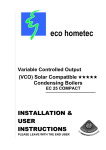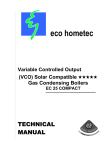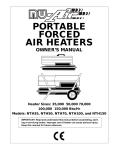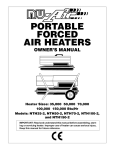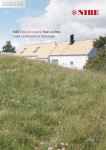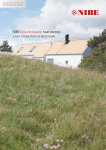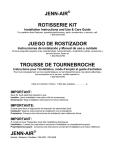Download Eco Hometec EC 38kW User manual
Transcript
eco hometec ecotherm underfloor heating For that feeling of comfort!! INSTALLATION & USER MANUAL eco hometec Unit 11E Carcroft Enterprise Park Carcroft Doncaster DN6 8DD Tel. 01302 722266 Fax. 01302 728634 e.mail. [email protected] http://www.eco-hometec.co.uk C:\Users\tim.bartlett\Documents\Marketing Backup\Manuals Various\underfloor heating1 files\Final Protected Versions\eco hometec new build installation manual Nov 2008 Emetti MF & ICMA BV.doc\ eco hometec has a policy of continuous improvement and reserves the right to change any specification without notice. Your statutory rights are not affected. 14 1 Filling & Pressurising the system 16 Pre-installation requirements 4 1.13 Opening Flow Meters 16 1.1 Screed Subfloor 4 1.2 Moisture barrier 4 1.3 Edge insulation strips 5 1.4 Expansion joints 5 2 Flooring screed 5 1.5 Flooring screed 5 1.6 Heat insulation 5 1.7 Floor irregularities 6 1.8 Pressure testing 6 1.9 Placing and Fixing the Manifold 6 1.10 eco hometec manifold 6 3 15 Filling the system 18 16 Pressurising the system 18 17 Starting up your system 19 1.14 Structural concrete: 19 1.15 Screed floors 19 1.16 Dry biscuit screed for timber floors 19 1.17 Anhydrite floor 22 18 Commissioning the System 22 19 Additives & Inhibitors 22 Distribution pipe work 7 1.11 Floor Types and Suitability 7 4 Installing the UFH pipe work 8 5 Installing Blue templates 10 6 Grip rails 11 20 Floor Finishes Suitable for Floor Heating 22 21 How to run your floor Heating System – using Setback. 23 1.18 With the System Control unit. 23 1.12 Tacker Gun 12 7 Manual Stapling By Hand 12 8 Wood floors on solid floors 12 9 Timber suspended ground floor. 13 10 Restrictions on Floor Depths 13 11 Suspended 1st & 2nd Floors. 14 1.19 Suggested operation 23 22 Maintenance 23 23 23 Fault finding: First check the following 24 Problem Solving 25 Figure 24 Placing and Fixing the Manifold 15 12 Fixing the manifold 15 13 Connecting pipes to manifold 15 underfloor heating1 new build installationl manual page 3 1 7. Make sure you fit the expansion edge insulation strips. Pre-installation requirements 8. Please check you have been delivered all components to complete installation in accordance with these instructions. Check your order corresponds with 1. Your invoice 9. Make sure the system is filled in line with instructions and pressure tested to 6bar before the floors are put down. This procedure not only ensures the system is watertight but helps to maintain the pipe shape during the screeding process. 2. Your CAD drawing and pipe schedule (this is to optimize roll lengths and will tell you which circuit to take of which roll). 3. Check you have the appropriate fixings for the installation & insulation 4. Check your floor construction corresponds with the CAD drawing & fixings Prior to the beginning of installation work, windows and doors should be in place and interior walls finished in order to ensure correct location of pipework The installation of this equipment should be carried out by a competent person and in accordance with the relevant, Building Regulations, Model Water Bylaws and the Building Standards (Scotland) Regulations. eco hometec shall not be responsible for any damage or loss resulting from failure to carefully observe the instructions given. The subfloor must be clearly swept and free of mortar residues before eco hometec system boards are put in place, to ensure that moulded floor templates lie evenly on the subfloor. Other trades should be excluded until installation is completed. 1.1 Installers should read this manual carefully. Responsibility for finished system function and operation rests with the installer. Please pay attention to the following points. 1. Make sure you understand the design and pay careful attention to pipe spacing. 2. Where pipes pass through walls they must be sleeved. 3. The CAD drawing supplied contains information on pipe centres and pipe run lengths read it. 4. Please ensure all timber joist notching complies with building regulations. 5. The software calculates the total amount of pipe required to complete the installation. Please make sure you optimise pipe supplied by calculating – before cutting – optimum lengths to be cut from each roll – please see CAD for cutting list. 6. eco hometec accept no responsibility for pipe shortages as a result of mistakes or failure to optimise pipe cutting. eco hometec installation manual page 4 Screed Subfloor The subfloor below the floor heating system must not contain joints, steps or cracks, etc. The working surface of the screed subfloor should be swept clean and be free of surface irregularities, mortar residues, pipes and pipe slots. Only under these conditions is a uniform flooring construction ensured. 1.2 Moisture barrier A moisture barrier may be required for basements or cellars. The barrier protects against ascending and lateral moisture. In all cases, the decision to install a moisture barrier depends on the particular construction circumstances and should be made on a caseby-case basis. The sealing of building components should then be carried out. If using Polystyrene floor insulation in selecting materials it should be ensured that only solvent-free polystyrene compatible materials are used. Compatibility with styrofoam is an absolute requirement. Tarred cardboard, etc. or patching and sealing substances containing solvents may not be used. Best suited for such purposes are asphalt-coated sealing tapes and plastic foils. Abutments should be overlapped and heatsealed. 1.3 Edge insulation strips Edge insulation strips permit the free expansion of flooring screed and prevents the transmission of impact sound to adjacent walls. The edge insulation strips must extend from the subfloor to the upper edge of the flooring layer and allow at least 5mm for movement of the flooring screed. The eco hometec edge insulation should be applied against all ascending construction elements such as walls, door frames or columns. 1.4 Expansion joints IMPORTANT: No single area of screed should exceed 40m2. Edging strip to form an expansion joint should separate areas greater than this. Create expansion joints by inserting a section of edge insulation strip between two system boards. Figure 1 Expansion joints 2 Flooring screed Standard flooring screed (1:4 with fibres is recommended) can be applied over eco hometec floor heating systems. The thickness of concrete layers used in the various constructions corresponds to the stability category specified for residential buildings. In most cases, a layer of 70mm (50mm above the upper pipe surface) is appropriate for direct embedding of the system. For flooring screed subject to increased stress and strain, e.g. warehouses, workshops, etc., flooring screed thicknesses are to be adjusted upwards according to actual static conditions. Depending upon the intended use, a special construction configuration may be required. Anhydrite concretes containing anhydrite binders as specified in DIN 4208 have no negative effect on floor heating system components. The low heat conduction factor should be taken into account, however. When using anhydrite concrete, appropriate insulation should be applied to protect against inflowing concrete. 1.5 Flooring screed Aggregate: gravel sand 0/8mm Mixture: cement :aggregates = 1:4 + fibres By weight (50kg cement = 225kg sand = approx. 26-28 shovels) + fibres. + 16-18 litre water to mix it (water quantity depends on moisture content of sand) 1.6 Joints are to be placed: • above existing building expansion joints at corresponding positions and in matching lengths • as field borders • as edge joints against all adjacent building elements and built-in fixtures Both flow and return pipes are run through the screed expansion joint and sleeved 400mm minimum either side. Heat insulation eco hometec UFCH can be permanently built into solid concrete or screeded floors. Insulation is built into the floor as required by current Building Regulations. IMPORTANT: Insulation thickness to comply with local building regulations and to satisfaction of Building Inspectors. underfloor heating1 installation manual page 5 1.7 Floor irregularities Where piping has already been installed on a subfloors prior to system board installation, a compensation layer of styrofoam can be laid to provide a level surface on which to place the system boards. System boards GTFN-F and GTFN-D can be cut with a profile cutter to fit over existing piping segments - a cost-effective alternative to the construction of a compensation layer. In no case, however, should granular fillers (e.g. sand) be used to build a compensation layer, as they are subject to hollowing, which can easily cause damage to pipe systems. 1.8 Pressure testing A test of heating system seal is performed at a pressure of 4bar before flooring screed is poured. This pressure is to be maintained until screed application is completed in order to ensure that any leaks are identified immediately. 1.9 Placing and Fixing the Manifold Place & install the manifold according to your CAD drawing eco hometec installation manual page 6 Although the control unit/ manifold has a built-in pump with a low noise level, we advise not to install the unit close to a bed, in a bedroom or behind a timber partition wall. Any noise could be increased due to the “sound box” effect created by the timber partitioning. The manifold should be fixed level and approximately 600mm above the finished floor.Ample space should be given to the manifold in order that the unit and pump can be serviced in the future. 1.10 eco hometec manifold Designed for ease of installation and to take up minimum wall space the eco hometec manifold offers the following benefits. 1. Flow & return temperature gauges. 2. Fixing kit. 3. Automatic air vents 4. Flow meters 5. Isolating valves Figure 2 eco hometec manifold 3 means of fixing to the floor and the underlay they use. Distribution pipe work The table below offers a guide only to pipe work and sizing according to the number of manifold ports. Extra consideration should be made if the route includes excessive bends or fittings. Ports/Circuits 2–7 2–7 8 - 10 8 - 10 11 - 20 1.11 F & R Length <14m >14m <4m >4m Pipe Dia. 22mm 28mm 22mm 28mm 28mm If this is too thick, (it should not exceed 2mm), it will insulate your floor. Concrete, screed, natural stone, slate and ceramic or quarry tiles all allow excellent heat transfer and heat output. Linoleum and Vinyl must be no thicker than 5mm. Important: ensure when gluing Lino/Amtigo to the concrete or screed that the concrete or screed is dry and all moisture is out. Get the heating running to dry out the floor. Floor Types and Suitability To ensure & achieve optimal heat output and temperatures, you require good contact between the floor structure and floor covering with no air gaps. Generally speaking thick cork & soft woods are not suitable for floor heating. Watch out for some of the new laminate boards and their Failing to do this could cause condensation on the underside of the flooring. Carpets - All carpets are suitable, however, the total carpet thickness should not exceed 12mm. If the carpet has a foam backing it must not be more than 3mm. Underlay is not necessary, the function of Underlay is to prevent wear & tear on underfloor heating1 installation manual page 7 the underside of the carpet, however usually a thinner, cheaper type is used - approx 3mm with no air pockets. The carpet can be laid loose, tensioned or glued to the floor. Chipboard, Ply, Wood, Laminate flooring - good contact with the floor is essential, avoiding air gaps, membranes for laminate flooring, must not be thicker than 2mm with no air pockets. Start up the heating to dry out the concrete or screed - ensure the concrete or screed is dry with all moisture out prior to applying any wood finish. Hardwood flooring – wood should have a moisture content of not higher than 10%. The total wood thickness should not exceed 22mm, ensure the concrete or biscuit is dry and all moisture is eliminated, prior to applying ANY wood finish – start up the heating to dry out the concrete or screed. NB. with all floor coverings, laminates, tiles, adhesives, grouts etc. check with the manufacturer prior to installation to confirm their suitability for use with under floor heating. Carpets etc should not exceed TOG value of 1. 4 Installing the UFH pipe work According to the floor construction method specified the following types of fixings are available. 1. eco hometec floor templates: Plastic board with studs to clip the pipes in between. 1. Plastic staples: Pipes stapled to an insulation which has a woven or plastic membrane attached to it. 2. Timber hammer clips: Plastic clips with nail attached, for use with joisted floor 3. Clip rails: Plastic rail nailed through the insulation on to the concrete floor by means of a plastic nail in to a pre-drilled 8mm hole. Identify and familiarise yourself with which method you are using. Make sure site is clear of water and debris, clear any rubbish and sweep clean the entire area. eco hometec under floor central heating can be eco hometec installation manual page 8 permanently built into solid concrete or screed floors. Insulation is either built either into or layed onto the floor as required by current Building Regulations. The following instructions show how to install your underfloor heating system on a solid concrete or block and beam floor. On a ground floor a minimum of 65mm foil backed insulation should be laid on top of the concrete slab or block and beam floor. The damp proof membrane should be laid below the concrete slab On a first floor a minimum of 30mm foil backed insulation should be laid on top of the block and beam floor. You only need another membrane above the insulation if you are having a liquid screed instead of a dry screed. Ensure the insulation is laid flat and that there are no gaps in the insulation. IMPORTANT: Prior to installing the manifold or any pipe you should have a clear understanding of either the CAD drawing with pipe layouts or, if you do not have a CAD, where you intend to fix the pipes and at what pipe centres. Tip If installing without a CAD then draw out your design on a piece of graph paper to a suitable scale that fits your room. It is important that pipes do not cross over and no circuit is greater than 100m long. As a guide you will need pipe at the following amounts. a) 100mm centres 10m per 1m2 b) 150mm centres 6.7m per 1m2 c) 200mm centres 5m per 1m2 Mark your manifold position on the paper and then draw in your circuit. Circuit patterns can be form one of those below. The pipe loops can be laid out in various patterns however the optimum pipe layout is normally achieved by mixing the flow and return pipes so that the pipe with the highest flow temperature is adjacent to the pipe with the lowest return temperature. This is commonly referred to as a reversed return or counter spiral layout. Examples of these patterns can be seen below: Serpentine patterns allow for the hottest water to border the exterior perimeter (highest heat loss areas). The water temperature is highest at the coldest walls and will decrease as it flows through the pipe towards the centre of the room. Figure 3 Pipe patterns Counter flow patterns differ from serpentine in that the supply and return pipes are laid out next to each other, creating an average temperature between them. Remember the following: 1. Pipes should be laid in a continuous length. 2. The maximum circuit length is 100m. 3. Connections must not be made in the area to be screeded. 4. Pipes must not cross over. 5. Do not forget to allow for connection lengths back to the manifold in overall circuit design and length. 6. If you area requires more than 100m divide it in half and fit two circuits of similar length. EG. Room area 13m2 pipes at 100mm centres pipe required 130m. Fix with two circuits of 65m. Figure 4 Installing the floor insulation Install the foam expansion strip around the entire perimeter of the area to be heated and across door ways or openings. Fix the strip in underfloor heating1 installation manual page 9 place by pushing black plastic staples through the strip and into the floor insulation or by using large head clout nails to fix the strip to the walls. Figure 7 Fixing Blue templates Figure 5 Fixing the edge insulation Take the next template and position it on top of the first one with the cut outs in the same position and press into place. IMPORTANT: If you are going to use a liquid screed you need to use an expansion strip with a thin polythene strip attached to it. Figure 8 Overlapping templates Figure 6 Edging strip for liquid and pumped screeds Fix the templates to the insulation using red plastic nails or staples. Figure 9 Securing down blue templates This polythene strip must be taped to the membrane that has been laid on top of the insulation with specialist floor screed tape in order to ensure a watertight seal. 5 Installing Blue templates When fitting the blue templates lay the first one in the right hand corner of the room with the cut out at at the far top left corner the other cut out will be diagonally opposite in the right hand corner. This is important to ensure correct interlocking of templates. Take the next template and position it on top of the first one with the cut outs in the same position and press into place. eco hometec installation manual page 10 When all the templates have been fitted the heating pipe is simply 'walked in' in line with the CAD or design and is then after pressurising and testing is permanently covered by screed. Figure 10 Walking in pipe 6 Grip rails These should be fixed to floor insulation using pipe staples 500mm apart and across the planned pipe work direction. Figure 11 Fixing grip rails The ecotherm floor templates hold the pipe against movement when screeding. Optimum screed depth is 65mm from panel base. IMPORTANT: If using pumped or self levelling screed care must be taken to ensure all gaps are sealed and no screed can get underneath the templates or insulation. Failure to observe this may lead to the templates floating on the screed with must be avoided. Pouring the screed from the middle is recommended as the weight of screed helps to stop the floor from floating. IMPORTANT: No single area of screed should exceed 40m2. Edging strip to form an expansion joint should separate areas greater than this. Create expansion joints by inserting a section of edge insulation strip between two system boards. Both flow and return pipes are run through the screed expansion joint and sleeved 400mm minimum either side. Figure 12 Pipe work should then be fixed into the grip rails. Use staples to fix pipes as they are turned to hold them into place. Figure 13 Fixing pipe turns When fixing to grip rails keep the coil laid flat on the floor and roll it out in front of you. Alternatively, a second person can roll out the pipe ahead of you whilst you fix the pipe. underfloor heating1 installation manual page 11 Figure 14 Fixing pipe 1.12 Tacker Gun If you are stapling the pipe directly to the insulation with tacker gun load the gun with staples. Figure 16 Tacker clips 7 Manual Stapling By Hand If you are stapling the pipe directly to the insulation keep the coil laid flat on the floor and roll it out in front of you. Figure 15 Loading tacker gun The staples should be placed over the pipe and into insulation at a minimum of 500mm centres. Space them as needed to hold the pipe firmly in place when bending the pipe at circuit ends. Alternatively, a second person can roll out the pipe ahead of you whilst you staple it to the insulation. Figure 17 Hand stapling 8 Wood floors on solid floors If installing a wood floor on top of a solid floor then an alternative fixing method is to fix 100mm timber supports to concrete sub floor at 400mmm centres. 50mm Kingspan or For these type of floors we recommend fixing sterling or equivalent boards to the underside of the joists. Staples come in strips of 30 ready to load onto dispenser. eco hometec installation manual page 12 Figure 18 Floor design when fixing wooden floor on concrete base. The pipes are then fixed in line with the CAD design to the insulation. Finally the sand and cement mix 1:8 is installed between the joists level with the underside of the finished floor. Please note: When installing under floor heating in timber floors a large quantity of pipe will need to pass across the joists. The joists will require substantial notching and this will inevitably weaken them. Figure 19 Pipe layout between joists at 100mm centres. IMPORTANT: When calculating floor joist dimensions do not forget to allow enough depth to accommodate pipe work and notches. Figure 20 Timber ground floors Timber frame houses with suspended ground floor installations will require an alternative installation. 10 Restrictions on Floor Depths 9 Timber suspended ground floor. For these type of floors we recommend fixing sterling or equivalent boards to the underside of the joists. Next fix 25mm x 50mm battons down the length of the joists so the top edge is 100mm lower than the finished floor. For installations with restrictions on floor depths or overall ceiling heights then eco hometecoffers a dry system board with an overall depth of 22mm. The system is suitable for refurbishments or new constructions where height restrictions apply and normal installation methods are not possible. Rockwool or equivalent insulation bats are laid on top of the boarding between the joists to finish level with the previously fixed battons. This system is ideal for timber framed properties or where structural restrictions do not allow the loading of ceilings with a sand and cement biscuit mix. Next cut and lay 50mm Kingspan or equivalent on top of the battons and above the Rockwool. The system utilizes wood-fibre boards with a thickness of 22 mm. When fixing to joists and 600mm centres additional timber support may be required if the Rockwool is not compacted enough to support the insulation properly. There are two types of boards. The first has routed grooves at 150mm centres along the length of the board, the second one is provided with routed wheels to enable the pipe underfloor heating1 installation manual page 13 to be returned and installed according to the CAD design. Edge insulation is fixed around the perimeter walls and the boards are simply laid and fixed across the joists in line with the supplied CAD and can be cut to shape with a standard wood saw. When calculating floor joist dimensions, allow enough depth to accommodate the UFH pipe work and notches. Figure 22 Suspended Floor System joists at 400mm The pipe is the fixed into the grooves in line with the CAD drawings. To finish the installation and to lock the pipes and boards in place the whole system should be covered with 3mm hardboard screwed to the plates. Dimensions of both types of boards are identical at 900/1350mm. The thermal conductivity coefficient of the heating board material is 0,1 W/mK, the specific gravity amounts to 750 kg/m3. 25mm of Kingspan or equivalent insulation should be fitted beneath the system boards. The preferred method of installation and an alternative to notching the joists is to install on counter battons as in the diagram below. Figure 23 System installed on top of existing suspended first floor. Figure 21 Dry system Boards Check your CAD drawing for individual room pipe centres. Figure 29 below shows typical pipes layout with pipes fitted between joists at 200mm centres. 11 Suspended 1st & 2nd Floors. ecotherm UFCH can be installed simply between the joists of a suspended floor. However, in order to maximise the efficiency and output we recommend laying a weak mix of sand and cement around the pipes and between the joists immediately under the finished floor. This gives the floor extra thermal mass and improves the overall output and performance of your heating system. IMPORTANT: When installing under floor heating in timber floors a large quantity of pipe will need to pass across the joists. The joists will require substantial notching and this will inevitably weaken them. eco hometec installation manual page 14 Figure 24 Placing and Fixing the Manifold 12 Fixing the manifold Place & install the manifold according to your CAD drawing. Although the manifold has a pump with a low noise level, we advise not to install the unit close to a bed, in a bedroom or behind a timber partition wall. Any noise could be increased due to the “sound box” effect created by the timber partitioning. Generally the manifold is mounted 600mm above the floor and should be level. It can be mounted at a different height, upside down or on a different floor to the one being heated. Discuss this with your technician. 1. Once this area has been installed, the pipe should be cut & connected to the front valve of the manifold and labeled. 2. If the pipe length is longer than the required area, several rooms may be coming from 1x larger coil, the pipe itself is clearly marked at every metre, to allow you to check how much pipe has been used. 3. Repeat the above until all ports have been installed & connected to the manifold. Pipes passing through the screed and up to the manifold should be sleeved 600mm either side. Ample space should be given to the manifold in order that the unit can be serviced in the future. 13 Connecting pipes to manifold 1. Pipes should be cut straight with a pipe cutter. 2. Do not use a saw of any type. 3. Slide nut & compression ring over the pipe & push hose pillar completely into the pipe. 4. Push the hose pillar with euro cone into the valve while holding the pipe, keep pushing upwards until nut is tightened, eco hometec installation manual page 15 tighten nut hand tight & turn 1 x further turn with spanner. 5. DO NOT OVERTIGHTEN 6. Make sure pipes/ circuits are labeled 14 Filling & Pressurising the system Figure 25 Filling & Pressurising Figure 26 Flow meters A test of heating system seal is performed at a pressure of 6 bar before flooring screed is poured. This pressure is to be maintained until screed application is completed in order to ensure that any leaks are identified immediately. Step 1 Lift up the white cap so it covers the flow gauge nut as in fig 29 below. Figure 27 Lift up the white cap System can be pressurized for testing purposes with water. REMEMBER: You must be extremely careful to avoid frost unless anti freeze has been added to the water. Recommended anti freeze is Alphi 11 from Fernox. 1.13 Opening Flow Meters The following steps show how to open each port to allow water to circulate through the system. This is in addition to opening the blue turn buttons on the top rack, (the return), of the manifold. eco hometec installation manual page 16 (If you take off the white cap completely, the flow meter should look like the fig 30 below although the flow gauge could have been unscrewed and be in a higher position as shown in fig 31 below. Figure 28 Figure 30 (If you take off the white cap now, the flow meter looks like fig 33 below. Note that the base of the flow meter is now raised.) Figure 31 Figure 29 Step 3 Push the white cap to the base of the flow meter so it clicks down as in fig 34 below. Step 2 Use the white cap to turn the whole flow meter anti-clockwise until the flow meter is open. (Alternatively, use a pair of grips) Remember the white cap needs to be lifted up halfway to cover the flow gauge nut. eco hometec installation manual page 17 Figure 32 9. Open first turn button (return rail) fully by turning anti-clockwise. 10. Open flow meter valve on same circuit by the following procedure: Unclip white plastic flow meter cap from metal base, (with the aid of a flat head screwdriver), and lift up slightly. Hold white cap over black plastic hexagonal nut so top of white cap is level with bottom of transparent section of flow meter. Turn white cap anti clockwise so black nut and black plastic base of flow meter valve turn with it. Flow meter valve will move upwards and will open after about five full turns. Water will now flow through circuit. Click white cap back down on its metal base. 11. Air vent caps need to be unscrewed to allow air to escape. Let water flow around circuit until there is a continuous flow of water through drain pipe with no air bubbles. You can now twist the flow gauge clockwise or anti-clockwise which adjusts the flow rate when the under floor heating system is in operation. For the time being leave the flow adjuster about halfway between the highest and lowest position. 15 Filling the system 1. Close isolating valves on manifold 2. Connect suitable filling pipes to drain and fill points. 3. Route pipe connected to drain point on return rail of manifold to suitable discharge spot. 4. Connect pipe from fill point on flow rail of manifold to cold water supply. 5. All turn buttons (return rail) will be closed as supplied. They can be closed by turning them clockwise. 6. All flow meter valves (flow rail) will be closed as supplied. 7. Turn on cold water supply at source. 8. Open valves on drain point and fill point by turning in the direction indicated on the valve. eco hometec installation manual page 18 12. When circuit is full and vented adjust flow meter by turning black nut clockwise until red marker shows a reading of approximately 2-3 L/min. 13. Close circuit by turning turn button (return rail) clockwise as far as it will go. Flow of water should stop immediately, if not, there is still air left in pipe. 14. Repeat steps 9 to 13 for next circuit on manifold until all circuits are filled and vented. 15. Once all circuits are filled and vented, open all turn buttons so that water is flowing through all circuits. 16. Close valve on return rail drain point and let pressure build for a few seconds before closing valve on flow rail fill point. 16 Pressurising the system Now that system is filled it needs to be pressurised to 6bar in order to test that it is completely sealed. Pressurise system to 6 bar using a Rothenberger pump or similar connected to the fill point. Leave for 10 minutes. After this time pressure should have dropped by no more than 1 or 2 bar. If pressure drops significantly, check system for leaks and make sure all connections are tight but not over tightened. Figure 33 Pressurising the system you can raise the temperature to 250C & increase daily by 100C. Note: Cracking may occur, this is not important as it is being covered any way You can apply a stronger mix i.e. 4: 1 this will allow contractors to walk over the screed without it crumbling up. Prior to the wooden floor being fixed. 17 Starting up your system The system can be started without room stats being connected, this is to allow a “drying out period “ as long as the Regulating stat & safety stat are fitted to the manifold To accommodate this, power the boiler, & system pump & manifold pump through the safety stat. 1.14 Structural concrete: If the pipes are fitted into a structural concrete floor and is more than 4 weeks old, the system can run @a temperature of 500C – this you set using the regulating stat. Boiler setting should be 700C & by pass @ manifold should be open, if the boiler is not of the condensing type. 1.15 Screed floors Screed floors should also be at least 4 weeks old, however on initial start up, start off with temperatures of 250C, then can be increase every other day by 5C until 500C has been reached, this slower process to avoid cracking & curling of the screed. 1.16 Dry biscuit screed for timber floors Dry biscuit screed for timber floors should be allowed to dry naturally for 2- 3 days after which eco hometec installation manual page 19 22mm Blending Valve for use with all manifolds up to and including 9 port Dimensions Description Thermostatic blending valve available with 22mm compression connections. RWC wax capsule technology ensures stable mixed water temperature. Suitable for blending the flow and return to achieve a stable system temperature in underfloor heating systems up to 200 square metres. 22mm 130mm Product Range HEAT 219 058 22mm Compression Performance 2.5 95mm 43mm Pressure (Bar) 2 Specifications 1.5 1 0.5 0 0 10 20 30 40 50 60 70 Temperature setting range: Flow supply temperature: Return supply temperature: Temperature stability: Working pressure, static: Working pressure, dynamic: Flow rate (L/M) Materials Body: Internal brass components: Seals: Spring: Piston: Fittings: Cast gunmetal, nickel plated DZR brass Nitrile elastomer Stainless steel Polysulfone polymer DZR brass 30°C to 60°C 85°C max. 5°C - 75°C + 2°C - 22mm 10 Bar max 6 Bar max. 0.2 Bar min. How to Specify Blending valve with 22mm compression connections for underfloor heating systems up to 200 sq meters. (Select appropriate range code). Guarantee All RWC products undergo strict performance tests prior to despatch, and are guaranteed against faulty materials and workmanship for one year from date of purchase. This is in addition to any statutory rights. Typical Installation FLOW TO MANIFOLDS (OR LOOPS) RELIANCE HEATGUARD UFH MIXING VALVE CIRCULATING PUMP RETURN FROM MANIFOLDS (OR LOOPS) ZONE VALVE ISOLATING VALVES Contacts: Sales Enquiries Telephone: Fax: E-Mail: +44 (0)1386 712400 +44 (0)1386 47148 +44 (0)1386 47028 +44 (0)1386 422217 [email protected] [email protected] Technical Support Reliance Water Controls Worcester Road, Evesham,Worcestershire, WR11 4RA, UK Tel: +44 (0)1386 47148 Fax: +44 (0)1386 47028 www.rwc.co.uk HEATUFH-002-10/02 P2 RWC reserves the right to make changes to the product which may affect the accuracy of information contained in this leaflet © Reliance Water Controls, Oct 2002 28mm Blending Valve for use with 10,11 and 12 port manifolds Dimensions Description Thermostatic blending valve available with 28mm compression connections. RWC wax capsule technology ensures stable mixed water temperature. Suitable for blending the flow and return to achieve a stable system temperature in underfloor heating systems up to 300 square metres. 28mm 146 Product Range HEAT 115 002 28mm Compression Performance 139 57 All dimensions in mm unless stated Pressure Loss (Bar) 2.5 Specifications 2.0 Temperature setting range: Flow supply temperature: Return supply temperature: Temperature stability: Working pressure, static: Working pressure, dynamic: 1.5 1.0 0.5 0 1 2 3 Flow (m3/h) 4 6 5 Ambient to 60°C 85°C max. 5°C - 75°C + 3°C 16 Bar max 6 Bar max. 0.2 Bar min. How to Specify Materials Body: Internal brass components: Seals: Spring: Piston: Fittings: Cast gunmetal DZR brass Nitrile elastomer Stainless steel Polysulfone polymer DZR brass Typical Installation Blending valve with adjustable temperature indicated on the cap and 28mm compression connections for underfloor heating systems up to 300 sq meters. (Select appropriate range code). Guarantee All RWC products undergo strict performance tests prior to despatch, and are guaranteed against faulty materials and workmanship for one year from date of purchase. This is in addition to any statutory rights. FLOW TO MANIFOLDS (OR LOOPS) RELIANCE HEATGUARD UFH MIXING VALVE CIRCULATING PUMP RETURN FROM MANIFOLDS (OR LOOPS) ZONE VALVE ISOLATING VALVES Contacts: Sales Enquiries Telephone: Fax: E-Mail: +44 (0)1386 712400 +44 (0)1386 47148 +44 (0)1386 47028 +44 (0)1386 422217 [email protected] [email protected] Technical Support Reliance Water Controls Worcester Road, Evesham,Worcestershire, WR11 4RA, UK Tel: +44 (0)1386 47148 Fax: +44 (0)1386 47028 www.rwc.co.uk UFH28-001-10/02 P2 RWC reserves the right to make changes to the product which may affect the accuracy of information contained in this leaflet © Reliance Water Controls, Oct 2002 1.17 refer to CAD drawing. If temperature is to low boiler may need adjusting. Anhydrite floor 19 Additives & Inhibitors Anhydrite floor should be left dry naturally for 10 days, after which the temperature can be set to 300C & stepped up 100C each following week to an absolute maximum running temperature 50600C. IMPORTANT: If higher temperatures are used, the water molecules within the screed will evaporate and the screed will turn to powder dust. 18 Commissioning the System 1. Confirm that the pipe stat is fitted at this final stage and check that all flow meters are opened 1 turn. The following additives have been approved for the system and will not invalidate your guarantee. They are all Fernox Products called 1. MB 1 – Inhibitor 2. Cupinol - Inhibitor 3. Alphi 11 – Inhibitor & Antifreeze If you live in an area with exposure to severe frost or leave the property unattended in the winter, we recommend you use Alphi 11 – a combined Inhibitor & Antifreeze See the product details for quantity required. 2. Switch the programmer to manual and ensure that it is calling for heat. 3. There should be no actuators fitted on this circuit, the manifold should pump should run and the zone valve should open. 4. The boiler should fire up. 5. Disconnect all actuators from manifold starting with zone 1. the 6. Turn the zone 1 room stat fully up. 7. After 3 minutes the actuator should open and the plastic window background display should change to red. 8. Fit the actuator to the appropriate valve on the manifold (on large floor areas there may be more than 1 actuator check CAD). 9. Now turn off zone one and activate zone two it is important to work methodically like this to ensure that the correct room stat is operating the appropriate actuator. 10. Repeat process until all actuators are checked. 11. Check system pressure is @ 1.5 bar & no further air is coming out of air vents. 12. Check that the temperature on the flow gauge reaches the required temperature eco hometec installation manual page 22 For your calculation, each group/zone on your system represents approx 12.5 litres of water. 20 Floor Finishes Suitable for Floor Heating Generally speaking to ensure & achieve optimal heat output, you require good contact with no air gaps. Cork & new soft woods are not suitable for floor heating. Watch out for ome of the new laminate boards, their means of fixing to the floor & foam membranes used. Foam membranes should be kept to the absolute minimum i.e. not more than 2mm Any stone finish, concrete, screed, natural stone, ceramic, quarry tiles or slate allows excellent heat transfer. Linoleum etc. Amtigo and other vinyl types are all suitable – IMPORTANT: ensure when gluing to the concrete or screed that the concrete or screed is dry and all moisture is removed – the heating should have run for a sustained period of time to ensure the concrete /screed is dry, failing to do this, could cause condensation on the underside of the flooring & consequential “bubbling” or delaminating. Carpets (including underlay) should not exceed 12mm, this can be laid directly on 19mm chipboard flooring, if using a suspended, timber joist system or directly on to the concrete floor. If the carpet has a foam back this must not be more than 3mm. Underlay is not necessary - the function of underlay nowadays is to protect the underside of your carpet from wear & tear. Normally a thinner, cheaper type is used - approx 3mm. The carpet can be then laid loose, tensioned or even glued to the floor. When glued the heat output is higher. Wood Finish: Hardwood flooring or Laminates Good contact is essential, avoiding air gaps. Moisture content of hardwood must not exceed 10% The total thickness should not exceed 22mm. Ensure the concrete or biscuit is dry and moisture has been removed prior to applying any wood. Failing to do so can lead to condensation under the wood which in turn will make the wood expand. 21 How to run your floor Heating System – using Setback. The system is designed to provide heat at the temperature requested by the room stat when the programmer is on. At other times the system will maintain a background temperature, which can be preset. This is called setback. 1.18 With the System Control unit. The programmer provides power to the room stats when the required heating program is on. The room stats regulate the room to the required temperature. When the programmer is in the off state, for instance when you are out during the day or overnight, the setback room stat will override the programmer and bring the system on if the temperature where it is located falls below its setting 160C is a typical setting for this. The set back stat should be in a location that is typical of the temperature of the house. Halls, landings, dining rooms and living rooms are good choice. Airing cupboards, above the manifold or in boiler rooms are not suitable for the stat location. 1.19 Suggested operation For best results set your system to come on two hours before getting up and to run down two hours before going to bed. Most Important ; Remember – room stats are thermostats/ sensors, NOT ON & OFF buttons. DO NOT adjust your room stats, more than a degree or two at a time Avoid dramatic swings from Low to High settings – simply adjust +/- 10C to 20C Chilly? Simply turn the room stats up 10C – 20C. Too warm? Simply turn the thermostat down by only 10C – 20C. Finally, once you are HAPPY and satisfied with the temperatures/ settings - leave them alone & forget about them….!! 22 Maintenance Pressure on your system should be checked regularly, this should be @ 1.5bar, if not top up using filling loop. 23 Fault finding: First check the following 1. Ensure all back valves area open by having the screw driver slot – vertical. 2. Ensure all front valves are open, by removing white caps & thermal actuators, check pin in valve moves freely in & out. eco hometec installation manual page 23 3. Ensure return valve to boiler is open, by having screwdriver slot vertical 4. If regulating valve is low, this should be set @ 500C - 700C. 5. Remove regulation valve & check if pin on valve moves freely – in & out. 6. Reconnect regulation valve, pump on manifold is running. check 7. Check boiler pump is running. 8. If system is properly filled according to instructions the flow temperature (bottom temp gauge) should be higher than return temperature (top temp gauge) – the difference between the 2 x temperatures should be approx 100C – ONCE the system is up to temperature. 9. Please remember the Initial “warm up or run in time in a concrete/screed floor is approx 4 to 8 hours before it comes up to temperature. eco hometec installation manual page 24 24 Problem Solving Symptons Flow pipe gets hot, return stays cool, even after many hours running, temperature on flow side not increasing. Flow & Return pipes both hot, but temperature on floor low. Pump not running, after being off for summer, floor does not want to heat up, pump seized. Room stat calling for heat, but no power to the pump. One room warm, other cold. One room not getting warm. Noise in system. Room gets too warm. Checks/Remedies Insufficient flow from boiler to manifold turn up speed of boiler pump. Flow & return to manifold wrong way round or manifold pump not running. Switch off pump, remove chrome screw in centre of pump, insert screw driver & turn shaft by hand to free shaft, replace chrome screw and switch pump back on. Safety stat on the manifold locked out or faulty,orr electrical connection problems. Check correct thermal heads on correct manifold ports. Air lock – flush through. Back valve on this circuit closed – open. Blockage or kink in pipes. Rubber washers on manifold fixing points not fitted or too tight. Manifold fitted on stub partition, acting like sound box. Tension on copper flow & return pipes. Air in system – due to wrong filling procedure No thermostatic control. Not connected to correct manifold port. Thermal head faulty/broken. Room stat faulty/broken. eco hometec installation manual page 25 Figure 34 Typical Wiring Schematic for multi room control with Danfoss wiring centre eco hometec installation manual page 26 Figure 35 Wiring example when only using CM907, high limit thermostat and pump. eco hometec installation manual page 27































